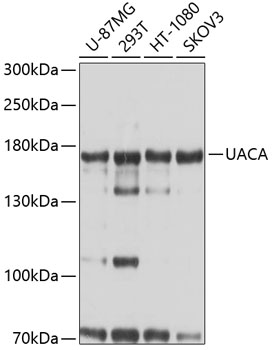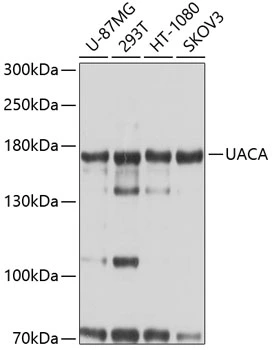![WB analysis of A549 cell lysate using GTX35155 UACA antibody [AE-5]. WB analysis of A549 cell lysate using GTX35155 UACA antibody [AE-5].](https://www.genetex.com/upload/website/prouct_img/normal/GTX35155/GTX35155_20200115_WB_47_w_23060819_780.webp)
WB analysis of A549 cell lysate using GTX35155 UACA antibody [AE-5].
UACA antibody [AE-5]
GTX35155
ApplicationsFlow Cytometry, ImmunoFluorescence, Western Blot, ImmunoCytoChemistry
Product group Antibodies
TargetUACA
Overview
- SupplierGeneTex
- Product NameUACA antibody [AE-5]
- Delivery Days Customer9
- Application Supplier NoteWB: 1-2microg/ml. ICC/IF: 1-2microg/ml. FACS: 1-2microg/106 cells. *Optimal dilutions/concentrations should be determined by the researcher.Not tested in other applications.
- ApplicationsFlow Cytometry, ImmunoFluorescence, Western Blot, ImmunoCytoChemistry
- CertificationResearch Use Only
- ClonalityMonoclonal
- Clone IDAE-5
- Concentration0.2 mg/ml
- ConjugateUnconjugated
- Gene ID55075
- Target nameUACA
- Target descriptionuveal autoantigen with coiled-coil domains and ankyrin repeats
- Target synonymsNUCLING, uveal autoantigen with coiled-coil domains and ankyrin repeats, nuclear membrane binding protein
- HostMouse
- IsotypeIgG1
- Protein IDQ9BZF9
- Protein NameUveal autoantigen with coiled-coil domains and ankyrin repeats
- Scientific DescriptionThis gene encodes a protein that contains ankyrin repeats and coiled coil domains and likely plays a role in apoptosis. Studies in rodents have implicated the encoded protein in the stimulation of apoptosis and the regulation of mammary gland involution, in which the mammary gland returns to its pre-pregnant state. This protein has also been proposed to negatively regulate apoptosis based on experiments in human cell lines in which the protein was shown to interact with PRKC apoptosis WT1 regulator protein, also known as PAR-4, and inhibit translocation of the PAR-4 receptor. Autoantibodies to this protein have been identified in human patients with panuveitis and Graves disease. Differential expression of this gene has been observed in various human cancers. [provided by RefSeq, May 2017]
- Storage Instruction-20°C or -80°C,2°C to 8°C
- UNSPSC12352203




![WB analysis of A549 cell lysate using GTX35156 UACA antibody [UACA/1222].](https://www.genetex.com/upload/website/prouct_img/normal/GTX35156/GTX35156_20200115_WB_48_w_23060819_286.webp)

